Guide By – Motorcycle Accident Lawyer Los Angeles Residents Can Count On
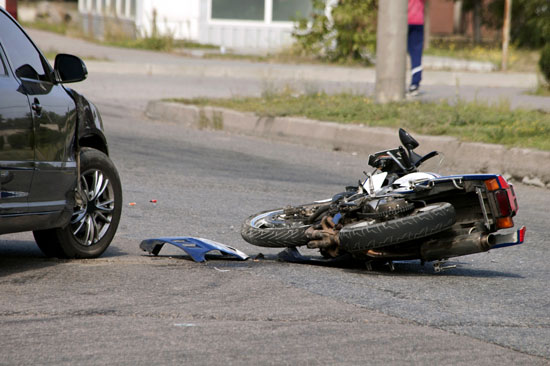 Victims of motorcycle accidents need unique qualifications, protection, and guidance of an expert motorcycle crash litigator. Cherepinskiy Law Firm is the motorcycle accident lawyer Los Angeles residents can rely on for justice! This firm has the expertise, thorough understanding of the applicable laws, best-qualified experts, and resources to handle the most complex cases.
Victims of motorcycle accidents need unique qualifications, protection, and guidance of an expert motorcycle crash litigator. Cherepinskiy Law Firm is the motorcycle accident lawyer Los Angeles residents can rely on for justice! This firm has the expertise, thorough understanding of the applicable laws, best-qualified experts, and resources to handle the most complex cases.
As Los Angeles becomes more and more congested and crowded, motorcycles gain more popularity as the mode of transportation that allows riders to spend less money on gas and get to destinations faster despite heavy traffic. However, negligent drivers and road hazards expose motorcyclists to the increased risk of getting involved in a motorcycle crash that can result in catastrophic injuries or death. Multiple drivers in Los Angeles and throughout California do not know how to share the road with motorcyclists. These drivers frequently make bad decisions, which lead to tragic consequences.
While modern automobiles have a multitude of continuously-evolving safety features, motorcyclists have virtually no protection besides their personal safety gear (helmets, protective clothing, gloves, and boots). Motorcycle safety gear can be effective in case of a minor skid or fall, but it will do little to protect the rider in case of an impact with a car, van, truck or bus. For multiple bikers, riding their motorcycle is much more than just commuting from point A to point B. The motorcycle gives them freedom and a sense of adventure. It is a major part of their life. However, a motorcycle accident can suddenly take that freedom and adventure away, leaving the victim with severe injuries, constant and excruciating pain, and piling medical bills.
If you make a decision to proceed with a legal action, the Los Angeles motorcycle accident attorney at Cherepinskiy Law Firm will provide competent, aggressive, as well as caring and compassionate representation. This firm pursues justice on behalf of motorcycle accident victims with passionate dedication. Cherepinskiy Law Firm provides legal services throughout Southern California and will work tirelessly in order to obtain the maximum compensation.
Motorcycle Accident Statistics
General Statistical Data Related to Motorcycles
- In the U.S., motorcycles represent a very small percentage (only 3%) of all registered motor vehicles.
- The annual miles traveled on motorcycles represent less than 1 percent (approximately 0.5-06%) of the combined annual mileage of all motor vehicles in the United States.
- Typically, in a near-accident situation, a motorcyclist has less than 2 seconds in order to make an attempt to avoid a crash.
- Statistically, most motorcycle crashes happen during short trips. Such trips include errands, shopping, and recreational activities.
- National Highway Traffic Safety Administration (“NHTSA”) estimates that, in case of a motorcycle crash, wearing a helmet reduces the risk of death by 37%.
- Based on the data from the Insurance Institute for Highway Safety (“IIHS”), those motorcycle riders who are wearing a helmet at the time of the accident – reduce their risk of suffering a brain injury by 67%.
- Flying objects – such as insects, dust, and debris – contribute to the occurrence of motorcycle accidents. Therefore, those who ride their motorcycles while wearing some form of eye gear (e.g. a helmet, glasses or goggles) reduce their risk of getting into a crash.
- Almost 50% of all motorcycle riders operate their bikes without any formal training.
- Intersections present the highest risk of a motorcycle crash. The majority of intersection accidents involve vehicles, which violate motorcyclists’ right-of-way.
- One of the major factors affecting the number of motorcycle accidents – is the drivers’ failure to see motorcycles. Frequently, drivers of other vehicles do not see a motorcyclist either at all or in time to avoid a crash.
- Approximately 2 percent of motorcycle crashes are the result of road defects (e.g. potholes, poorly covered road repair sites, uneven surfaces, etc.).
- Motorcyclists in their twenties and fifties have the highest risk of getting involved in a crash.
- In single-vehicle crashes (i.e. where the motorcycle was the only vehicle involved in the accident), over 60% are the result of an error on the part of a motorcyclist. These errors include, but are not limited to, excessive braking, speeding, or taking curves or corners too wide.
Motorcyclist Fatalities in the United States
The statistical data from the NHTSA shows that the number of motorcyclist fatalities in the United States is once again on the rise. NHTSA reports the following data with respect to the number of motorcyclists killed in traffic accidents during the period of 1996 through 2016:
– YEAR Motorcyclist Fatalities
– 1996 2,161
– 1997 2,116
– 1998 2,294
– 1999 2,483
– 2000 2,897
– 2001 3,197
– 2002 3,270
– 2003 3,714
– 2004 4,028
– 2005 4,576
– 2006 4,810
– 2007 5,174
– 2008 5,312
– 2009 4,469
– 2010 4,518
– 2011 4,630
– 2012 4,986
– 2013 4,692
– 2014 4,594
– 2015 5,029
– 2016 5,286
– Total 84,236
In 2016, the number of motorcyclists who died as a result of motor vehicle collisions was 5,286, which represents the highest number of annual fatalities since 2008 and the second highest number of annual deaths since 1996. In fact, since 1996, the number of annual motorcycle accident fatalities more than doubled. Over the 20-year period, from 1996 to 2016, over 84,000 motorcyclists were killed in traffic crashes. Considering these high numbers, and the complexity of motorcycle crash issues, such cases should be handled by the motorcycle accident lawyer Los Angeles riders can trust.
Based on the statistical data from the NHTSA, in 2016:
- The number of motorcyclists killed in 2016 in traffic accidents was 5,286, which represented:
-
- a 5.1% increase compared to 2015;
- a 15.0% increase compared to 2014; and
- a 144.6% increase in annual fatalities compared to 1996
- Out of the 5,286 motorcyclists who died in motor vehicle collisions, the vast majority – 4,950 (94%) were operating their motorcycles at the time of the crash. Only 336 (6%) were passengers.
- In 2016, the number of motorcyclists killed in traffic collisions was six (6) times higher than the number of deaths involving occupants of passenger cars.
- For the same number of traveled miles, in 2016, the frequency of traffic crash fatalities involving motorcyclists was twenty-eight (28) times higher than the frequency of accident fatalities involving occupants of passenger cars.
- In terms of the types of crashes that resulted in motorcyclist fatalities, 55% of affected motorcycles collided with other vehicles and 23% crashed into fixed objects.
- Among the 2,625 two-vehicle fatal collisions:
-
- 72% of motorcycles suffered a front-impact crash;
- 7% of affected motorcycles were rear-ended;
- 41% involved vehicles making left turns while motorcyclists were proceeding straight or were engaged in passing or overtaking maneuvers;
- 23% involved accidents where both the motorcycle and the other vehicle were going straight.
- A third (33%) of motorcyclists involved in fatal accidents were speeding at the time of the crash.
- Over a quarter (27%) of all fatal motorcycle accidents involved riders who were operating their bikes without a valid license.
- Over a third (37%) of all motorcyclists who were killed in single-vehicle traffic crashes – were operating their motorcycles under the influence of alcohol.
- Among all motorcycle fatalities, regardless of the type of the crash, 25 percent involved riders with the blood alcohol level that was equal to or exceeded the legal limit of 0.08 g/dL. Approximately 7 percent of motorcyclists killed in accidents had blood alcohol level that was less than 0.08 g/dL (0.01 g/dL – 0.07 g/dL).
- Among all fatal accidents involving alcohol impaired or intoxicated operators, the incidence was considerably higher for motorcyclists than for drivers operating other types of motor vehicles:
-
- Motorcycles – 25 percent;
- Passenger cars – 21 percent;
- Light trucks – 20 percent; and
- Large trucks – 2 percent.
- Among fatal collisions, the frequency of motorcyclists riding their bikes under the influence of alcohol was 3 times higher for nighttime crashes than for daytime accidents.
- The lives of 1,859 motorcyclists were saved because they were wearing helmets at the time of the crash.
- If all motorcyclists involved in traffic accidents had been wearing helmets, the number of saved lives would have been 2,661 (i.e. 802 more motorcyclists would have been able to save their lives).
Motorcyclist Deaths in California
- In 2016, out of the 4,950 motorcyclist fatalities that occurred in all of the states combined, 529 motorcyclist fatalities (10.69%) took place in California.
- In 2016, among all motor vehicle fatalities in California, over 15% involved motorcyclists.
Motorcyclist Fatality Statistics for Los Angeles
- Among all states in the U.S., California has the highest number of registered motorcycles.
- In 2015, traffic collisions in Los Angeles resulted in the deaths of 2,123 motorcyclists.
- Although motorcycle crashes represent only approximately 3% of traffic accidents in Los Angeles, they constitute 15% of all traffic fatalities in the city.
Motorcycles Do Not Offer the Same Protection as Automobiles
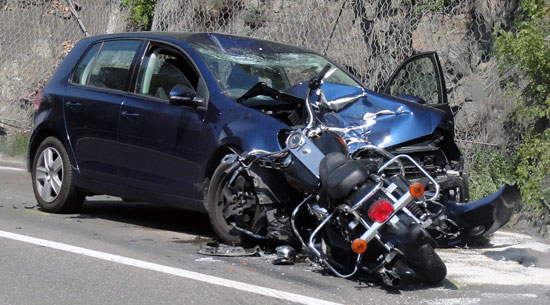 Modern automobiles offer a variety of safety features, which range from seat belts to airbags. In addition, the body of an automobile serves as a protective “cocoon” for drivers and passengers. Motorcycles do not offer any of these protections. Due to their very design, in case of an accident, motorcycles make their riders and passengers much more vulnerable and likely to sustain serious injuries than drivers and passengers of virtually any other motor vehicle. The following are some of the factors, which predispose motorcyclists to suffer severe injuries or fatalities:
Modern automobiles offer a variety of safety features, which range from seat belts to airbags. In addition, the body of an automobile serves as a protective “cocoon” for drivers and passengers. Motorcycles do not offer any of these protections. Due to their very design, in case of an accident, motorcycles make their riders and passengers much more vulnerable and likely to sustain serious injuries than drivers and passengers of virtually any other motor vehicle. The following are some of the factors, which predispose motorcyclists to suffer severe injuries or fatalities:
- In case of an accident, motorcyclists are exposed to the direct force of impact by other vehicles and/or the road surface.
- Motorcycles are considerably lighter and smaller in size than cars and most other vehicles on the road, especially buses and trucks. Therefore, even a relatively low-impact crash has the potential to cause motorcyclists to suffer catastrophic injuries or death.
- Since most motorcycles are equipped with only 2 wheels, they are inherently not as stable as other motor vehicles.
- Due to their size, motorcycles are not very visible to other traffic participants. As a result, drivers of motor vehicles may tailgate motorcyclists or cut them off, open doors without seeing an approaching motorcycle, and otherwise create dangerous situations.
- Finally, road defects such as potholes, cracks, and uneven surfaces are significantly more hazardous for motorcycles than for cars, buses, and trucks. A poorly maintained roadway can easily cause tragic consequences for a motorcycle rider.
If bike riders cannot be protected by motorcycles themselves, if they get in a crash, they need the assistance of the motorcycle accident lawyer Los Angeles residents believe in.
Types of Motorcycle Accident Injuries
A motorcycle accident may lead to very serious and catastrophic injuries, as well as a fatality. The following is the listing of the most common injuries that can be caused by a motorcycle crash:
- Amputation and loss of limbs
- Back and neck injuries
- Bruising
- Blindness and eye injuries
- Burns
- Concussions
- Crush Injuries
- Cuts and scrapes
- Disfigurement and permanent scarring
- Fractures and broken bones (non-displaced, displaced, and compound fractures)
- Hearing Loss
- Hematomas (Internal bleeding)
- Internal injuries
- Joint Damage
- Post-Traumatic Stress Disorder (PTSD)
- Skin Injuries
- Soft tissue injuries
- Spinal cord injury and paralysis
- Traumatic brain injury (“TBI”)
- Whiplash
- Wrongful death
If you or a loved on suffered an injury as a result of a motorcycle crash, you need the assistance of a motorcycle accident attorney Los Angeles residents can turn to for legal help.
Common Types of Motorcycles
Touring Motorcycles
Touring motorcycles are designed to make touring (i.e. long road trips) as comfortable and safe as possible.
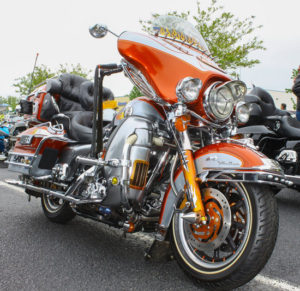
These motorcycles, especially “full-dress” touring bikes, typically offer various luxury amenities that include the following:
- Large fairings – fiberglass or plastic shells, which partially or completely surround the front of a motorcycle
- Windshields, which may be incorporated into fairings. They are intended to protect riders from wind, water splashes, road debris, dust, and other potential airborne hazards
- Extensive bodywork
- Large fuel tanks
- Powerful engines with excellent torque and horsepower at lower RPMs (revolutions per minute)
- Upright, relaxed, and comfortable riding position
- Comfortable seats, which are frequently equipped with backrests
- Side and top luggage compartments
- Radios and media players
- Heated hand-grips
- Navigation systems
- Air compressors
- Air bags
- Air suspension with compressors
Cruisers
Cruisers are motorcycles, which maintain the main appearance elements, style, and design features of classic American motorcycles built during period from the 1930’s to 1960’s. These bikes are reminiscent of the classic Indian and Harley-Davidson machines. The seating position is typically upright with the high handlebar placement.
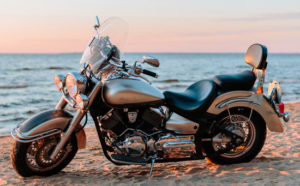
More powerful cruisers are called “power cruisers”, and they typically have a modern appearance and come equipped with stronger brakes and softer suspensions. Well-equipped power cruisers are essentially touring motorcycles.
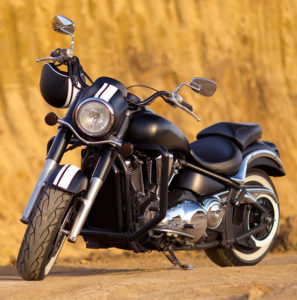
Choppers
Choppers originated in California. The first motorcycles of this type were built in the late 1950’s. Initially, these motorcycles were created by cutting and modifying (“chopping”) stock motorcycles. Modern choppers can be built from scratch. There are multiple companies that offer various chopper kits and contain all parts necessary to build a motorcycle – from frames and bodies, to engines, wheels, brakes, seats, handlebars, and all other components. There are also various enthusiasts and professional bike shops, which specialize in creating unique and beautiful choppers.
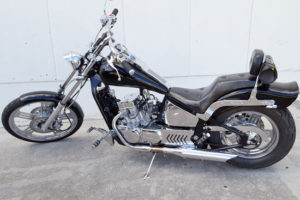
Classic choppers have an unmistakable stretched-out appearance. The “chopper look” is achieved by placing extremely long forks (telescopic shock-absorbing tubes for the front wheel) at increased rake angles. Other typical features of a custom chopper are as follows:
- Multiple chrome-plated parts
- Expensive custom paintjobs, which frequently include airbrush art
- Hardtail frames – frames where the rear wheel is attached directly to the frame and without any springs or shock-absorbers
- Lengthened frames
- Large front wheels
- Custom handlebars, which are either (1) extremely high (“ape hangers”) or (2) super short (“drag” handlebars)
- A high “sissy bar” (also called “passenger backrest” or “sister bar”) – a curved tube attached to the rear fender that can be used as a backrest. Sissy bars are typically either black or chrome plated.
Sport Bikes
Sport bikes (also called “sportbikes” or “sports bikes”) are motorcycles designed to be extremely fast and maneuverable, while providing supreme braking capabilities.
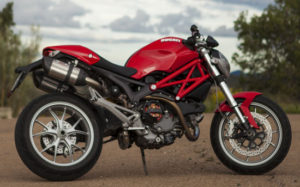
The following are features common to virtually all sport bikes:
- Powerful engines
- High-performance brakes, which are designed not to “fade” (i.e. experience a reduction in the stopping power) in extreme heat conditions
- Frames that are built using lightweight materials
- Aerodynamic bodies and fairings, which are frequently made out of expensive fiberglass
- “Clip-on” handlebars – short handles, which are typically attached directly to the fork tubes
- An emphasis on ergonomics (as opposed to rider comfort). Specifically, foot pegs are located higher and closer to the rear than on other types of motorcycles, which makes a rider “hug” the motorcycle’s body with his or her legs. In addition, the handlebars are located so low and far away from the seat that, in order to reach the controls, the rider has to lean forward and essentially lay on top of the gas tank.
There is a sub-category of sport bikes, which is called “naked bikes” or “streetfighters”. These motorcycles have significantly reduced or even absent bodywork and fairings, as well as higher handlebars that allow riders to sit in a relatively upright position.
Sport Touring Motorcycles
Sport touring motorcycles represent the hybrid of a sport bike and a touring motorcycle. For example, these motorcycles have multiple characteristics of sport bikes, such as light frames, powerful engines and aerodynamic bodies. At the same time, they offer features typical for touring bikes – e.g. luggage compartments and a more comfortable seating position.
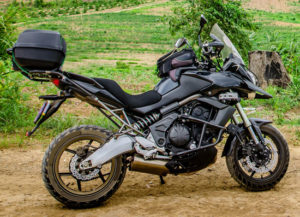
Dirt Bikes
These motorcycles are designed for off-road competitions and recreational activities.
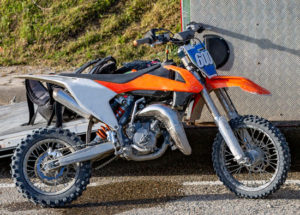
Dirt bikes fall into several categories:
- Motocross bikes. In motocross, bike racers compete on natural terrain courses with various specially-constructed obstacles.
- Supercross bikes. Supercross competitions are conducted inside stadiums or special arenas, and involve multiple turns, curves as well as jumps.
- Enduro bikes. Enduro racing events are competitions that test riders’ endurance – hence the name “enduro”. This type of off-road motorcycle competition is extremely challenging and difficult. Riders have to travel a long distance, while overcoming the following obstacles: tree logs, tree branches that hang too low, and multiple uphill and downhill stretches involving rocks, water, dirt, sand, gravel and mud. Enduro motorcycles are designed to withstand long hours of abuse. For riding at night, these bikes typically have headlights as well as taillights.
- Trail bikes. These motorcycles are very similar to enduro bikes in terms of design and construction. They are intended for mostly recreational (as opposed to competitive) riding along various naturally-occurring trails.
- Dual-sport motorcycles. These bikes are designed to be operated on paved roads as well as off-road. They have all equipment necessary to be “street-legal”, including mufflers and other required emissions-control components, speedometers, horns, mirrors, headlights, etc. Some heavier models with bigger engines are also referred to as “adventure-touring bikes”.
Although all dirt bikes may have a somewhat similar appearance, they are not all “the same”. Depending on the specific sport or activity dirt bikes are designed for, they can be equipped with a wide variety of different engines, gearboxes, suspensions and other items of equipment.
In California, many dirt bikes are not “street-legal” and cannot be registered. Nevertheless, dirt bikes that are compliant with the requirements set by the California Air Resources Board (CARB), such as some dual-sport bikes, can be registered and operated on public streets and highways.
Scooters
Scooters are small bikes, which are equipped with 50cc to 250cc engines offering a very modest power output.
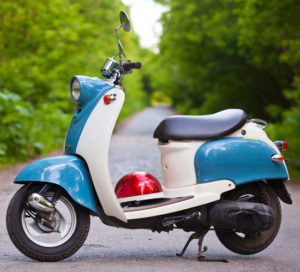
Most scooters are equipped with low step-through frames, platforms for feet, as well as various shields protecting riders from greasy engine-related parts and components. One of the major differences between motorcycles and scooters is the gearbox. Motorcycles have purely manual sequential gearboxes with wet clutches. With the exception of some vintage scooter models, the majority of scooters feature “automatic” gearboxes, which are technically called “continuously variable transmission (CVT)”.
Common Causes of Motorcycle Accidents
Since motorcycles are not nearly as stable as motor vehicles with four or more wheels, even relatively minor road hazards – such as wet asphalt, loose gravel, or potholes – can result in a motorcycle crash with tragic consequences. As the following examples show, many motorcycle crashes are the result of another driver’s carelessness:
- Speeding and Motorcycles: When drivers are speeding, their ability to avoid an accident is compromised because high speed reduces the time drivers have to apply brakes or make an evasive maneuver. As a result, speeding leads to a high number of motorcycle crashes, which occur in a wide variety of circumstances ranging from left-turn collisions to rear-end accidents.
- Failure to See Motorcyclists when Driving under the Influence: Alcohol and drugs severely impair drivers’ judgment and reaction time. Motorcycles are small and not easy to visualize even for sober drivers. However, when drivers are under the influence, the level of danger to motorcyclists is significantly higher.
- Motorcycle Accidents Caused by Distracted Driving: Despite efforts to increase public awareness of the dangers of distracted driving, many drivers on modern roads and highways continue to engage in distracted driving. Drivers operate their vehicles while they are reading and sending text messages or e-mails on their smartphones, drinking, eating, applying makeup, adjusting radios and other types of media players, talking to other occupants in their vehicles, daydreaming or just being too “focused” on the road scenery. These distracting activities are extremely hazardous for all traffic participants. However, motorcyclists are particularly vulnerable. Cars, vans, trucks, and buses are significantly heavier than motorcycles. When distracted drivers operating their heavy steel machines crash into unprotected motorcyclists, these accidents frequently lead to catastrophic injuries and fatalities.
- Failure to Yield to Motorcyclists: Automobiles outnumber motorcycles on the U.S. roads and highways. Motorists are accustomed to watching for approaching cars and trucks; not so much for motorcycles. As a result, many drivers may fail to see a motorcycle – a much smaller vehicle than they expect to see. Motor vehicle operators must always remember that motorcycles are regular traffic participants. A failure to yield can lead to tragic consequences when drivers run into motorcyclists while making left turns or merging into oncoming traffic.
- Violations of Motorcyclists’ Right-of-Way: When a driver is entering street traffic from an alley, a side street, a parking lot, or a driveway – all vehicles on the street the driver is merging into have the right-of-way, including motorcycles. A violation of this right-of-way may result in the driver crashing into a motorcyclist. When a car or a truck hits a motorcycle during a lane-change maneuver, this is another example of the right-of-way crash involving motorcyclists.
- Left-Turn Motorcycle Crashes: This type of a collision happens when a motorcyclist is proceeding through an intersection, and a vehicle going in the opposite direction tries to make a left turn right in front of the motorcycle. As a result, the motorcyclist has little time to react and slow down, and hits the left side of the offending vehicle “head on”. Frequently, left-turn motorcycle crashes end up in a fatality.
- Failure to Check Blind Spots as a Cause of Motorcycle Crashes: Every vehicle has blind spots on all four sides. The largest blind spot is always on the side, which is opposite to the driver’s side. In the United States, vehicles are “left-hand drive” – i.e. the driver’s seat is on the left. Therefore, the largest blind spots for the U.S. motor vehicles is on the right side, especially for commercial vehicles such as trucks and buses. A driver can negligently fail to check his or her blind spots before changing lanes, overtaking another vehicle, making a turn, or performing other maneuvers. If, at that moment, a motorcyclist is in one of the blind spots, it can lead to tragic consequences.
- Rear-End Crashes into Motorcycles: Typically, such accidents occur when a motorcycle is waiting for a green light at an intersection, and a negligent driver slams into the rear of that motorcycle. Upon impact, the motorcyclist may fall on the ground, get hit by the car that rear-ended the bike, or even end up being propelled into the oncoming traffic and run over by another vehicle. When a rear-end accident involves a motorcycle, it can lead to catastrophic injuries or even the death of the motorcyclist.
- “Open Door” Accidents: Most commonly, this type of an accident occurs when a vehicle parallel parks on a street. Without first making sure there is no oncoming traffic, a driver can carelessly open the driver’s door or allow rear-seat passengers to exit through the left rear door. As a result, a door may suddenly and unexpectedly fly open causing the motorcycle to crash into it.
California Motorcycle Safety Laws
California enforces multiple laws and regulations pertaining to motorcycle safety. Most of these regulations are contained in the California Vehicle Code (“CVC”). The motorcycle safety regulations, which range from the required safety gear and equipment to maneuvers and carrying passengers, are as follows:
- In California, at all times when a motorcycle is in motion, all motorcycle drivers and their passengers are required to wear helmets. [CVC 27803]
- Safety helmets have to comply with the standards set forth by the United States Department of Transportation (USDOT).
- Motorcycles have to be equipped with a rear-view mirror providing a view of at least two hundred feet. [CVC section 26709] Although only one mirror is required, it is considerably safer to operate motorcycles with dual mirrors (i.e. a mirror on each side).
- Motorcycle seats may not be installed so high that, while sitting in the seat, drivers are unable to reach the ground with their feet. [CVC 27801(a)]
- When a driver is seated on a motorcycle seat, the handlebars may not be positioned more than 6 inches above the operator’s shoulder height. [CVC 27801(b)]
- All motorcycles, which were built and first registered on or after 1/1/1973, must be equipped with properly working and functioning turn signals on both the front and rear. If a motorcycle was built prior to January of 1973, it is exempt from the turn signal requirement.
- Motorcycle operators have to signal their intention to make a turn at least one hundred feet (i.e. 5 seconds when traveling at highway speeds) from the point of the intended turn or lane change.
- The California Motorcycle Anti-Tampering Act became effective on January 1, 2013. Based on this law, all motorcycles and aftermarket exhaust systems manufactured in 2013 and later – must display an affixed EPA label certifying compliance with Federal sound emissions standards. All motorcycles and emissions components built prior to the effective date of the law are exempt from this requirement.
- The practice of passing motor vehicles within the same traffic lane is called “lane splitting” as well as “lane sharing” or “filtering”. When a motorcycle is engaged in lane splitting, it often proceeds between two vehicles traveling in adjacent lanes. Based on the new law that went into effect in 2016, lane splitting is now legalized for motorcyclists riding on any street, road, or highway in California.
- In terms of lane splitting and the safety of motorcyclists, several California laws are very helpful:
-
- In California, it is illegal for motor vehicle operators to drive at a speed, which is so slow that it blocks or impedes reasonable and normal traffic movement. When it is necessary for safety, road conditions, or compliance with other laws, low speeds are allowed. [CVC 22400]
-
- California motorists (both drivers and passengers) are not allowed to open the door of their vehicle on the side of the road available to other vehicles, including motorcycles. Similarly, it is illegal to leave the door open for longer than it would be necessary to allow loading or unloading of passengers. Of course, opening doors in a reasonably safe manner and without interfering with traffic movement is allowed. [CVC 22517]
- When two or more motorcycles ride parallel to each other (i.e. side-by-side) in a single traffic lane – this practice is called “lane sharing”. In California, lane sharing is not prohibited.
- California has no law or regulation specifying the minimum age for motorcycle passengers. Nevertheless, carrying passengers is allowed only on motorcycles equipped with footrests as well as seats securely attached behind the driver. [CVC 27800]
The motorcycle safety laws are very complex, and you need the services of the motorcycle accident lawyer Los Angeles can trust to know these regulations well.
Insurance Requirements for Motorcyclists
In California, motorcycle operators must comply with the following minimum liability insurance requirements:
- $15,000 for bodily injury or death to a person
- $30,000 total for bodily injury or death (if a crash involves multiple people)
- $5,000 for damage to property
In case of a motorcycle accident, the failure to comply with these minimum insurance requirements may subject a motorcycle driver to the suspension of his or her driver’s license. In addition, if a motorcyclist cannot provide proof of insurance during a routine traffic stop, the motorcycle may be impounded and the driver may have to pay a fine.
Safe Driving and Riding Practices – Avoiding Motorcycle Accidents
Watch Out for Cars Turning Left at Intersections
- When you are riding through intersections – be careful!
- When you see an approaching vehicle, look at its turn signals for an indication that the vehicle is about to make a left turn. If the blinkers are on, adjust your speed to provide the car with sufficient room to complete the turn.
- If the car starts making a left turn without using a turn signal, you may not have enough time to stop safely. Instead, depending on the circumstances, you may have to either make an evasive maneuver or speed up to avoid being hit by the turning vehicle.
Obey Speed Limits
- The importance of following speed limits cannot be underemphasized! When you are speeding on a motorcycle, in case of a sudden and unexpected situation, you may not have enough time to stop or swerve. Speeding can cause you to:
-
- Run into a pedestrian or a vehicle
- Get into a water spot and hydroplane
- Crash if you take a turn fast
Never Ride Under the Influence of Alcohol
- Never drink alcohol and ride your motorcycle!
- If you consumed alcohol, call a taxi cab or a rideshare service.
Assume Drivers Cannot See You and Act Accordingly
Visibility is one of the toughest challenges for motorcyclists because of the motorcycles’ small size compared to other vehicles, as well as blind spots and drivers’ inattention. Follow these steps to minimize your risks:
- When you are in close proximity to any vehicle – a car, van, truck, bus, etc. – assume that the driver of that vehicle does not see you and act accordingly.
- If you see a car backing up, stop and wait for the car to complete its maneuvering.
- Always provide space for vehicles merging into your lane – e.g. slow down a little and let the car merge in front of you.
- Avoid blind spots by positioning your motorcycle either behind a vehicle or in front of it.
Watch Out for Road Hazards
Always be on the lookout for road hazards, which include but are not limited to, the following:
- Vehicles which are stopped in your lane (either parked or broken down)
- Spilled oil and other liquids
- Water puddles
- Sand
- Tree branches
- Rocks and gravel
- Wet leaves
- Potholes
- Metal sheets temporarily covering road work sites
Use Rearview Side Mirrors
- Regularly check your mirrors because it makes your ride safer.
- For instance, if you see that a vehicle in the neighboring lane has turned its blinker on and is about to merge into your lane and on top of you, you will have an opportunity to make an evasive maneuver and avoid getting hit by that vehicle.
Be Extremely Cautious When Lane Splitting
In California, lane splitting is legal. It can be very tempting to ride between cars in order to save time, especially during rush hour traffic. Nevertheless, this practice can lead to tragic consequences:
- A car may suddenly merge into your lane and either cut you off or crash into you
- A car door may unexpectedly swing open right in front of you (if you are riding next to a lane of parked vehicles)
Therefore, the safest way to deal with lane splitting is to – avoid it completely! However, if you do decide to lane split, follow the safety tips issued in 2018 by the California Highway Patrol (CHP):
- Take your surroundings into account. These are important factors to consider:
-
- the size of the vehicles around you
- lane width
- lighting
- weather (e.g. rain or strong winds)
- pavement condition
- In general, it is not safe to lane split when traveling next to buses, semi-trucks, and other large vehicles
- For the purposes of lane splitting, the far-left lanes are generally the safer than the other lanes
- Never linger between vehicles
- Avoid vehicles’ blind spots
- The higher the speed of traffic – the riskier it is to lane split
- Ride with high beams on even during daytime
- Wear protective gear, which is reflective or brightly-colored
Protect Yourself from Rear-End Collisions at Intersections
When a motorcycle is stopped at a red light, it runs the risk of getting rear-ended. In order to minimize this risk, use the following approaches while you are waiting at intersections:
- Pull in front of an already-stopped vehicle
- Stop between cars in adjacent lanes
- Do not stop in the middle of the lane. If you are closer to the “edge” of the lane, it will be easier for you to make an evasive maneuver and avoid getting hit.
Do Not Enter Corners and Turns at High Speed
High speeds make it extremely difficult to navigate tight or sharp turns. If your speed is too high for a particular curve, you may fall or even fly off the roadway. You do not know what is waiting for your behind that sharp curve. If your front wheel unexpectedly gets into a water puddle or gravel, in a split second, your motorcycle will be on the ground.
- Do not speed through sharp turns.
- Never enter corners at high speeds.
- Gauge the direction of the road and the sharpness of an upcoming turn by visual clues such as trees, telephone poles, and light posts.
- Use the “Slow In, Fast Out” approach. Enter sharp turns at a lower speed and, once your range of vision improves, you can accelerate out of the turn.
- If you underestimated the severity of a turn and entered it at a high speed:
-
- Do not panic!
- Do not accelerate to correct the turn.
- Do not slam the brakes.
- Do not chop the throttle (i.e. abruptly release the throttle control).
- Instead – lean into the turn and make an effort to ride the turn out. While you are doing it, operate the controls as smoothly as possible.
Make Sure You Know How to Operate Brakes Properly
- Do not grab the front wheel brake abruptly. If you do it, the powerful front brake will “lock” the wheel – sending your motorcycle into the “front wheel skid”, loss of control and a crash.
- Do not apply the rear brake only. This unsafe practice can lead to the following potentially catastrophic consequences:
-
- The rear wheel will skid and you will be unable to change the direction of your motorcycle until it either stops or crashes into something.
- The rear wheel will “fishtail” and, if you correct it and the bike straightens out, you may get thrown off your motorcycle.
- Your stopping distance will be very long, which may not provide you with enough time to make a complete stop and avoid an accident.
- When braking, steer straight and apply brakes in a steady and constant manner.
- Motorcycle experts believe that the most appropriate braking method is to use both – the front and rear brakes at the same time. In terms of the braking effort (the force with which the rider applies brakes) – approximately 70% should be focused on the front wheel, and 30% should be directed to the rear wheel.
- The 70/30 ratio can be altered depending on the type of motorcycle. For example, cruisers can tolerate heavier rear-wheel braking because their seats are positioned closer to the rear of the bike. On the other hand, due to their vertical forks and short wheelbases, sport bikes can handle heavier front-wheel braking.
- Finally, if you want to be able to apply front or rear brakes as hard as possible with a reduced risk of locking wheels, skidding, fishtailing, etc. – make sure your motorcycle is equipped with anti-lock brakes (ABS).
Always Wear Protective Safety Gear
Whenever you ride your motorcycle, wear safety gear. The most important component of safety gear is – a helmet. Motorcycle helmets save lives! Safety gear items include, but are not limited to, the following:
- A helmet
- Protective clothing – pants and jackets or one-piece racing suits. The riding gear can be made out of leather or special fire-retardant materials. Regardless of what material it is made of, this category of safety gear is commonly referred to as “leathers”.
- Brightly-colored or reflective stripes on the protective clothing
- Body armor
- Gloves
- Riding boots
Regularly Maintain Your Bike
Always make sure your motorcycle is regularly maintained:
- Change tires on a regular basis. Never ride on worn out tires because it can lead to the loss of traction (sliding or skidding), and consequences can be devastating.
- Make sure wheels are always properly aligned and balanced.
- Promptly replace worn out brake pads.
- Change the oil as instructed in the owner’s manual.
Never delay getting your bike diagnosed and repaired. Whenever you hear a weird noise or feel that brakes, throttle or steering controls are not operating properly, it can be a sign of an impending component failure. Have your motorcycle inspected by a mechanic right away! If you procrastinate, you may end up in a crash.
What Damages Can be Recovered in Motorcycle Accident Cases?
Victims of motorcycle accidents can claim the following two main types of damages: Non-Economic and Economic damages. In some situations, those who have been injured in a motorcycle crash may potentially seek Punitive Damages. For cases involving future care, the Los Angeles motorcycle accident lawyer at Cherepinskiy Law Firm retains top expert physicians, life care planners, and economists to evaluate clients’ needs and present the best case on their behalf. A detailed discussion of the recoverable damages is included on the Personal Injury Damages page of this website.
If a motorcycle accident resulted in the death of a loved one, then compensation can be sought in a Wrongful Death action.
Take Action! Promptly Contact a Los Angeles Motorcycle Accident Attorney for a Free Consultation
The value of any motorcycle accident claim depends, in part, on what you do immediately after the accident and subsequent to that. Your decisions and actions can seriously impact your claim and the amount of your potential recovery. Read this firm’s discussion of Twelve Steps to Take After a Motor Vehicle Accident to learn about post-accident safety, obtaining and preserving evidence, dealing with insurance companies, and other useful tips.
If you believe your injuries or a loved one’s death occurred as a result of a motorcycle crash, please call or fill out an electronic contact form today to request a free consultation. Cherepinskiy Law Firm, as the Los Angeles motorcycle accident lawyer, will work in a tireless and compassionate manner in a personal injury or a wrongful death case to make sure you are compensated for your injuries and losses.
This firm fights for clients throughout California, including Los Angeles, Orange County, as well as Ventura, Riverside and San Bernardino Counties.
Sources
1. https://www.nhtsa.gov/road-safety/motorcycle-safety
2. https://www.chp.ca.gov/programs-services/programs/california-motorcyclist-safety







